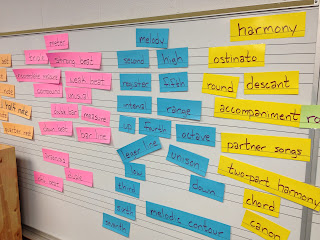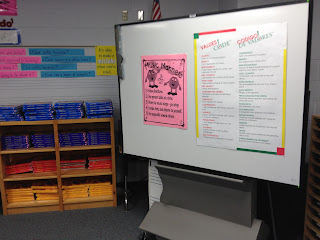Beat
Let's start with "the beat." In the broad sense, I want my students to understand:
- The beat is steady, only speeding up or slowing down for expressive reasons.
- The beat helps musicians perform together.
- The beat is more often something that is felt rather than heard.
Because the beat is so basic, there really isn't a "breakdown" of what to teach at each level. However, here are a few suggestions...
Pre-K - lots of opportunities to move to the beat - dances, parachute play, clapping and moving body parts to the beat, playing the beat on rhythm instruments. For tempo, being able to identify the beat as "fast" or "slow" is good enough at the ripe old age of four.
Kindergarten - even more of the above. In this grade I do like to introduce the term "tempo" and practice identifying some basic tempo markings such as allegro, presto, andante, and largo.
First through Fifth Grades - more movement and playing of the beat and identifying tempo. In fifth grade I do try to make a stronger emphasis on the fact that the beat is felt rather than heard in many pieces of music. I address tempo-related concepts as they arise in the literature we happen to be using (accelerando, ritardando, etc.).
Rhythm
The next logical progression from beat is rhythm. What they need to know at a core level:
- Rhythm is the division of sounds and silences over the beat as variations of long and short.
- We read rhythms by reading the "stick part" or stems of the notes.
Kindergarten - still more practice identifying beat as opposed to rhythm and vice versa. I avoid actual notation reading at this level, but we address rhythms in terms of long and short as in B-I-N-G-O - long, long, short-short, long. I also use picture notation at this grade level - big pictures for long sounds, small pictures for short sounds, and we do actually read the quarter rest for a beat of silence. There are many good materials (old and new), and I have a book called Kinderjams! that is ingeniously listed on the J.W. Pepper website as a "recorder book" (see my bio on this blog about being pigeon-holed as a "recorder guy"). If you're interested, I still stand by the collection and its awesomeness. I still use it, and my kids love the recordings. Check it out here.
First Grade - begin to read simple four-beat and three-beat rhythm patterns using quarter notes, quarter rests, and paired eighth notes. We read these using rhythm syllables but, experience has shown me that we need to drill, drill, and drill some more about the difference between what the note is called and how we say the notes in a pattern. I do not like asking, "What kind of note is this?" and getting an enthusiastic answer back, "TA!" No, it is not a "ta" - it is a quarter note. I also have learned that it is important to introduce rhythmic notation with the note heads on the notes. This way I can show students notes with stems up and with stems down and they learn there is no difference. Using the tradition "stick notation" from Kodaly does avoid this, but they will be seeing music printed with note heads, so why not start it off that way?
Second Grade - continue to read the first grade patterns, introduce eighth notes both with flags and with stems. Again, it is important to call things by their correct names so students don't have to do double the work. Calling things by cute names may seem like fun to an adult, but really...why teach young children it's a "this" when it's actually a "that?" It just doesn't make sense to me. This is also the year that we begin to read longer note values - half note, dotted half note, and whole note. I introduce the corresponding rest with each and we also discover the tie. Additionally we learn the dotted quarter-eighth note pattern. I don't get into the whole mathematics of the dot - it's not appropriate at this level (they really don't understand fractions at this age - some may, but I'm telling you, a true understanding of the concept just isn't developmentally there yet for the most part). What I do is put up a pattern with a pair of eighth notes in it. I separate the pair on the next line using individual flagged eighths, then write it again tying a quarter note to one of the eighths, and then saying, "We have a much shorter way of writing this..." Amazing. We also discuss the fermata in second grade.
Third Grade - we continue to review all of the note values from previous years. This is the exciting time when I introduce the concept of syncopation. This is a tough one to get across, so we visit the topic more than once during the school year. Third grade is also a good year to introduce triplet eighth rhythms. I don't really introduce much more new rhythmic material to their repertoire at this age because they really need to get a lot of practice in reading and performing rhythm patterns in all the various combinations using whole, half, quart, and eighth notes and rests as well as with ties and syncopation - that's a lot for the eight-year-old mind to get a handle on.
Fourth Grade - again, all of the previous and then I add the study of sixteenth notes in all combinations - two sixteenths and an eighth, an eighth and two sixteenths, four sixteens, dotted eighth followed by a sixteenth, and a sixteenth followed by a dotted eighth. We continue to read rhythms using only syllables at this age level. This is also the age when logical thinking can be addressed when related to music. I introduce the idea here that "we add something to the note, it gets shorter, we take something away, it gets longer." I demonstrate this with a hole note, add a stem, add some coloring, add a flag, and add another flag. You'll know you've hit it when they ask, "Can you have more than two flags?" and then you say, "Sure! What do you think the next type of note will be called?" If you get "Thirty-second!" on the first try, you're doing a whole lot better than I ever have. If I have a class that's really catching on, I'll go into the math side of it - dividing fractions! Oh my!
Fifth Grade - My students have the opportunity to study a band or orchestral instrument when they are in middle school. Before I send them off to the big and thrilling world of sixth grade, I make sure they know how to count rhythms using the "one-and" method since band directors as a group will never lower themselves to the elementary level of syllable reading (even though it makes a heck of a lot more sense!). We review all previous years' rhythms throughout the year and toward the spring I do a big "one-and" lesson and they get it. Why? Because at this point they are ready. They've had lots of experience with notation in the previous years (at least while they were with me) and now whether you call two-eighths "ti-ti" or "hotdog" or "one-and" it's kind of a moot point. They know when they see that pattern what it should sound like. I also take time to review the whole "add something to the note and it gets shorter" discussion from fourth grade.
Well, there you have my take on the elements of beat and rhythm. Tune in next week when we'll go into the mysterious realm of meter and melody.
Until then...



.JPG)












